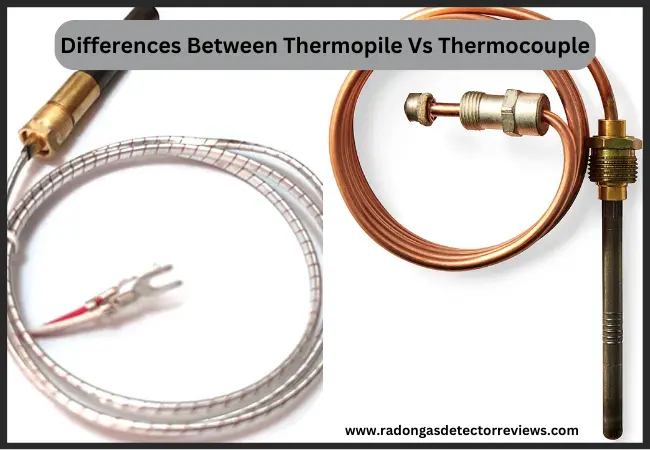Thermocouples and thermopiles are two types of temperature sensors. People can sometimes use the terms interchangeably or get confused between the two. But these sensors work in different ways. Let us tell you what exactly they are for and how they differ – thermopile vs. thermocouple.
Table of Contents
Differences Between Thermopile Vs Thermocouple

Thermocouple
A thermocouple is a simple device consisting of two wires of different metals joined at a junction. When this junction is heated, it generates a small electrical voltage proportional to the temperature difference between the two ends of the wires. This voltage can be measured and used to determine the junction’s temperature.
Thermopile
A thermopile, on the other hand, is a more complex device that consists of multiple thermocouples connected in series. Each thermocouple generates a small voltage when heated, and these voltages are added together to produce a larger output voltage. This allows thermopiles to generate higher output voltages than thermocouples, making them better suited for applications requiring higher sensitivity, such as infrared thermometers and gas detectors.
Thermopile vs. Thermocouple
Here are some of the critical differences between thermopiles and thermocouples:
Construction:
A thermocouple consists of two wires of different metals joined at a junction. A thermopile, on the other hand, consists of multiple thermocouples connected in series.
Output Voltage:
The output voltage of a thermocouple is relatively low, typically around 50-100 millivolts. The output voltage of a thermopile is higher, typically in the range of 100-1000 millivolts.
Sensitivity:
A thermocouple is less sensitive to temperature changes than a thermopile. This is because the output voltage of a thermocouple is directly proportional to the temperature difference between the two junctions, while the output voltage of a thermopile is proportional to the total amount of heat absorbed.
Cost:
Thermocouples are simpler and less expensive than thermopiles.
Applications:
Thermocouples are used in various temperature-sensing applications, including industrial processes, automotive applications, and scientific research. Thermopiles are used in applications that require higher sensitivity and accuracy, such as infrared thermometers and gas detectors.
Temperature Range:
Thermocouples can operate over a wide range of temperatures, from -300°F to +4500F. Thermopiles typically have a more limited temperature range, from -58°F to +930°F.
Frequently Asked Questions (FAQs)for Differences Between Thermopile vs Thermocouple
Q1.What is the lifespan of a thermopile compared to a thermocouple?
The lifespan of both thermopiles and thermocouples depends on the materials used and the operating conditions. Generally, thermocouples have a longer lifespan compared to thermopiles.
Q2.How do thermopiles and thermocouples generate a voltage?
Both thermopiles and thermocouples generate a voltage through the Seebeck effect. This effect occurs when two dissimilar metals are joined together and exposed to a temperature gradient. The temperature difference causes a flow of electrons, generating a voltage across the junctions.
Q3.What is the sensitivity of a thermopile compared to a thermocouple?
Thermopiles are generally more sensitive than thermocouples, as they have more junctions and can generate a higher output voltage.
Q4.Which is more accurate: a thermopile or a thermocouple?
Both thermopiles and thermocouples can provide accurate temperature measurements when used correctly. However, the accuracy of the measurement depends on factors such as the materials used, the calibration of the device, and the environmental conditions.
Q5.Can a thermopile and a thermocouple be used interchangeably?
No, thermopiles and thermocouples cannot be used interchangeably. They have different properties and are used for different applications.
Q6.What are some common applications for thermopiles and thermocouples?
Thermocouples are commonly used for temperature measurement in industrial processes, scientific research, and HVAC systems. Thermopiles are often used in non-contact temperature measurements devices, such as infrared thermometers and thermal imaging cameras.
Q7.What is the lifespan of a thermopile compared to a thermocouple?
The lifespan of both thermopiles and thermocouples depends on the materials used and the operating conditions. Generally, thermocouples have a longer lifespan compared to thermopiles.
Q8.Which one is more cost-effective: a thermopile or a thermocouple?
The cost of both thermopiles and thermocouples varies depending on the specific device and application. However, thermocouples are generally less expensive compared to thermopiles.
Q9.What are some common applications for thermopiles and thermocouples?
Thermocouples are commonly used for temperature measurement in industrial processes, scientific research, and HVAC systems. Thermopiles are often used in non-contact temperature measurements devices, such as infrared thermometers and thermal imaging cameras.
The Bottom Line
In the thermopile vs. thermocouple debate, here’s our take – Thermocouples are simpler and less expensive but less sensitive and accurate than thermopiles. However, thermopiles are more costly and complex but provide higher sensitivity and accuracy in temperature sensing applications.
Thermocouples and thermopiles are both useful for temperature measurement and sensing applications. They are commonly used in industrial processes, automotive applications, scientific research, and consumer products such as home thermostats and ovens.